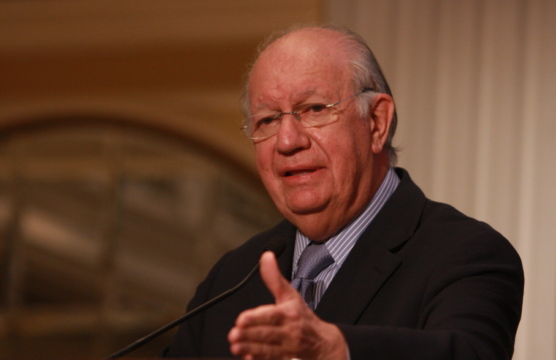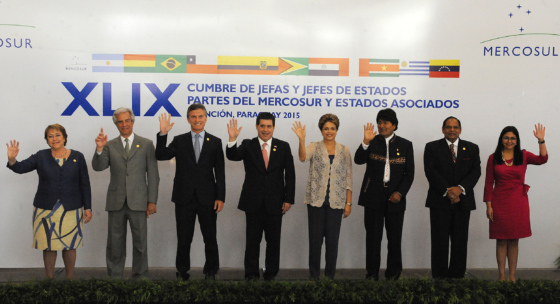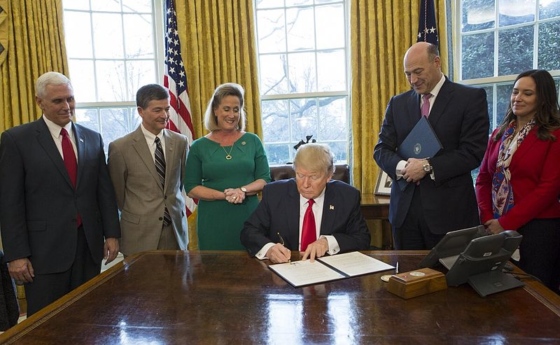
A Time for Action
Latin America inequality gap, economic integration, and infrastructure and education systems were among the issues spotlighted at the XVII Annual CAF Conference.
This post is also available in: Español
This is an especially difficult moment for much of Latin America. After almost a decade of solid economic performance across the region, leading to sharp declines in poverty, measurable decreases in inequality, and an expanding middle class, nearly every country is slumping economically and some face prolonged stagnation and recession. Throughout the region, these reversals—resulting in most places from varied combinations of poor economic management and slowing Chinese demand for Latin America’s commodity exports—have contributed to the sagging public confidence in governments, which has made the policy adjustments needed for recovery harder.
Polls show extremely high disapproval ratings for presidents, political parties, and legislatures, with serious governance crises erupting in many nations. Although democratic rule has so far proved remarkably resilient in most countries, democracy and the rule of law have been dangerously weakened in more than a few places, while record levels of criminal violence intrudes on daily life in many others. Making things still worse have been a series of highly publicized corruption scandals involving senior public officials and top business leaders.
There is positive news to report as well, however. Most governments understand and are pursuing the adjustments and reform measures needed to re-energize their economies and lift growth rates. In several countries, judicial institutions are working more effectively than ever to investigate and prosecute corruption, while ordinary citizens are demanding greater accountability and higher quality public services from their governments. Unlike most other regions of the world, Latin America remains largely at peace, mostly free of armed conflicts, internally and externally. Particularly encouraging is the prospect that, by next year, the negotiations taking place in Cuba between the Colombian government and the FARC guerrillas could end half a century of internal war in the Andean republic. The reconciliation between Cuba and the US, of course, is another promising advance, which closes the chapter on a similarly lengthy period of bilateral hostilities.
Most Latin American governments today are heavily focused on their domestic problems, looking inward not regionally. They are absorbed by foundering economies, sizable governance challenges, and spreading crime and corruption. Countries like Brazil, Venezuela, and Chile, which not so long ago were energetically reaching beyond their borders to build regional political and commercial alliances, are now forced to direct their attention to the home front. Along with the Latin America’s economies, most initiatives toward greater integration have stalled. The region’s most deeply troubled nations—including Haiti, Venezuela, Honduras, Guatemala, and Cuba—are not getting much support from neighboring countries. In only a few cases, however, such as the confrontation between Venezuela and Colombia, are we witnessing outright hostilities, and none of them are expected to escalate in any dangerous fashion.
Latin America’s integration schemes so far seem mostly toothless and ineffectual, partly because each country is mainly focused on pursuing its own national agenda. The region’s governments are certainly not providing the leadership needed to pursue regional initiatives. The six-country Mercosur group has become dysfunctional. Its members disagree fundamentally on trade strategies and economic policy—and the economies of the group’s three largest members (Brazil, Argentina, and Venezuela) are profoundly distressed with little chance of recovery soon. The immense political and security challenges confronting nearly every Central American country, compounded by ample distrust among their governments, have made it difficult to purse cooperative initiatives on the isthmus. Latin America’s most promising economic integration scheme, the Pacific Alliance, is likewise hampered by the domestic political and economic tribulations of its four members (although considerably milder than those of the Mercosur or Central America).
Similarly, the regional and subregional political organizations newly established over the past dozen years in Latin America are also faltering. Inspired by Cuba, the militantly anti-US group, the Bolivarian Alliance of the Peoples of the Americas (ALBA), has been enfeebled by the death of its charismatic founder and leader Hugo Chavez and by Venezuela’s collapsing economy. And the rationale for ALBA has substantially weakened with the US–Cuban rapprochement. UNASUR, the Union of South America Nations, often touted as a potential Latin American substitute for the Organization of American States (OAS), has not yet shown the capacity necessary to address, even in minimal fashion, such regional crises as the collapsing institutions (public and private) and economy of Venezuela and the rising tensions between the Bolivarian Republic and Colombia. Conceived and organized by Brazil, but today without effective leadership, UNASUR lacks authority and direction. Finally, CELAC, the Community of Latin American and Caribbean Nations, which brings together every nation in the hemisphere aside from the US and Canada, serves as little more than a forum or a conference.
The arguments for regional integration are strong, and are getting stronger. A divided and squabbling Latin America will remain a weak participant in an increasingly competitive global economy. Without a more unified outlook and coordinated approach, Latin America’s potential role in shaping global institutions and critical international decisions will continue to be limited. It will also remain at a disadvantage in its negotiations with countries like the US and China, and with the EU and other more integrated regions.
Latin America’s record on regional cooperation has been exceedingly disappointing so far, on both economic and political dimensions. The region, for example, has not been able to offer solutions to Venezuela’s deepening crises or to its border confrontation with Colombia, nor has it been able to find common approaches to the pervasive problems of drugs, violence, and corruption. Improvements now seem unlikely in the continuing absence of (a) active and sustained leadership from region’s major countries, particular Brazil and Mexico, and (b) substantially increased agreement on the central issues of governance, rule of law, and economic management. Integration will also require a willingness of Latin American nations to temper their demands of absolute sovereignty over their internal affair and turn to collective regional action when valued regional norms and interests are at stake.
Certainly the two trade groups do not collaborate very much. At the same time, they are by no mean antagonistic, and there is no reason to believe they will not eventually find more opportunities for cooperation, and begin to satisfy the Chilean vision of “unity in diversity”. For sure, the two groups are today deeply divided by divergent economic policies. Mercosur countries have much higher trade barriers, and have signed far fewer free trade agreements than their Pacific Alliance counterparts. Still, there are considerable trade and investment flows between them. Although the three largest Mercosur countries are in far worse circumstances, the Alliance members are also confronting painful economic and political challenges, which may provide a basis for some closer cooperation. It is also possible, however, that unless Mercosur overcomes its damaging inertia, the differences between the two economic groups could widen. The Pacific Alliance nations may well see a more promising future in their association with the recently negotiated Transpacific Partnership involving the US, Canada, and six Asian nations.
Although not necessarily shared equally by every country, a general consensus has emerged in Latin America regarding the norms and values that should govern a more integrated region. It includes the concepts of democratic rule (periodic free elections, freedom of expression and association, and separation of powers), as well as protection of human rights, commitment to social equity and inclusion, and reliance on a combination of state and market mechanisms to propel economic growth. These standard, however, are frequently ignored or actively violated in many countries. Moreover, it is discouraging that, by and large, Latin America governments are more concerned about avoiding any hint of outside interventions or violations of their sovereignty than they are about identifying mechanisms to protect and advance widely recognized regional values. That concern may reflect the region’s bitter memories of unwanted and often harmful interventions from the US. But it makes it difficult for Latin American nations and their regional institutions to deal cooperatively and effectively with continuing transgressions against democracy, human rights, free press, and other norms.
No one has yet come up with a formula, principles, or policy framework for achieving a more constructive US relationship with Latin America. The basic ideas are obvious ones. They include mutual respect, equality of treatment, cooperation on issues of shared concern, are reciprocal support during periods of hardship. But these are so general, and subject to such varying interpretations that they do not provide much guidance. With the huge differences among the countries of Latin America and changes over time in external and domestic circumstance of each, it is hardly possible to identify any common approach or methodology.
As the region has become more diverse, independent, and assertive, it has become harder and harder to pin down the meaning of US-Latin American relations. It will take a more unified and cohesive Latin America to revive the concept. Mexico and most other near neighbors of the US in Central America and the Caribbean have strong, close relations with the US with a high degree of economic and demographic integration. The nations of South America are far less entwined with the US. The US relationship with Latin America has now evolved to be little more than the sum of its relations with each country. When Latin Americans speak of regional cooperation today, they usually mean cooperation with other Latin American nations, not with the US.
Most Latin American nations know the importance of US trade and investment for their economies, and are eager to have productive economic ties with the US. Most of the region welcomes having the US as an economic and commercial partner, but they are also building partnerships with Europe and China, and other countries worldwide. South American countries no longer see a continuing role for the US in resolving regional political or security challenges. Given the huge asymmetry in power and wealth between the US and Latin America, the many issues and interests that divide them today, and historical memories of US abuses, there is likely always to be a degree of tension in the relationship, which at times can turn to hostility and conflict. While the recent reconciliation efforts between the US and Cuba should eliminate a poisonous irritant to US relations with the region, it is unlikely to significantly reshape the relationship.
At this point, it is hard to see CELAC as key mechanism for regional integration or as a prominent actor in US-Latin American relations. It is, of course, still a very young, incipient organization that serves mainly as a public forum. It is hard to know whether it can or will develop into an institution that has the capacity and resources to mobilize member countries, build a commitment to regional unity and cooperation, and effectively join national forces to confront Latin America’s many challenges. What almost certainly will be required for CELAC to evolve in these directions is a robust commitment and strong leadership from the major countries of the region, which it does not yet have. China has identified CELAC as useful institutional framework for managing its relations with Latin America, but the Asian giant continues to conduct most of its diplomacy and economic engagement on a bilateral basis.
Latin America inequality gap, economic integration, and infrastructure and education systems were among the issues spotlighted at the XVII Annual CAF Conference.
The intensity of the clash within Mercosur highlights how much has changed in South America since Venezuela joined the bloc four years ago.
Cuts to Washington’s energy engagement could undermine the connections that help support U.S.–Latin American cooperation on issues from security to immigration. When it comes to weakening energy integration in the Americas, there are few winners.


